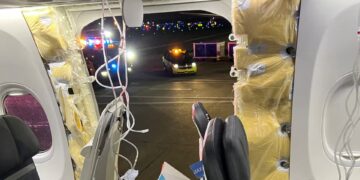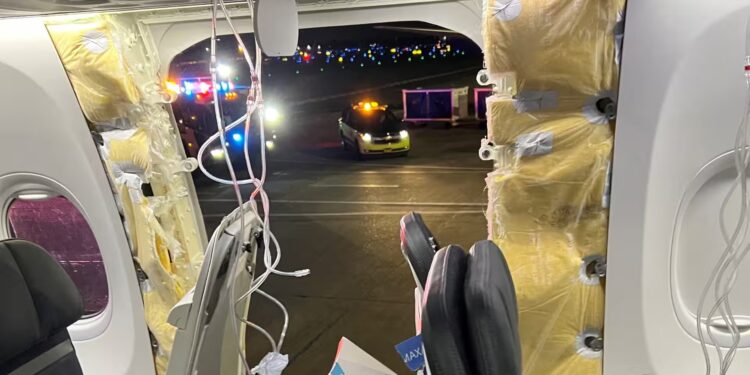By John Ikani
Alaska Airlines imposed restrictions on the Boeing aircraft involved in a mid-air incident following pressurization warnings in the days leading up to Friday’s occurrence, according to investigators.
The affected Boeing 737 Max 9 was barred from undertaking long-haul flights over water, as shared by Jennifer Homendy from the US National Transportation Safety Board (NTSB).
The NTSB revealed that the missing section of the plane was located in the backyard of a Portland teacher.
Fortunately, no injuries were reported during Friday’s dramatic incident. The Boeing 737 Max 9, which experienced a fuselage blowout, executed a safe emergency landing upon returning to its departure city, Portland.
The flight bound for Ontario, California, carried 177 passengers and crew members. Presently, the Federal Aviation Administration (FAA) has grounded 171 planes of the same model for ongoing safety inspections.
Despite Alaska Airlines briefly returning some Max 9s to service, the FAA intervened on Saturday to ensure safety.
Alaska Airlines had reassured the public, stating they found “no concerning findings” during their own assessments.
Homendy, during a news conference, disclosed that pilots had reported pressurization warning lights on three prior flights involving the specific Alaska Airlines Max 9.
The decision to limit extended flights over water aimed to facilitate a swift return to an airport in case of recurring warnings.
It remains unclear if there’s a direct link between the previous warnings and the incident on January 5. The affected plane, delivered to Alaska Airlines in October, had received FAA approval for airworthiness at that time.
Homendy shared new details about the chaotic situation on board Alaska Airlines flight 1282. The force of the blowout opened the cockpit door, causing items like a laminated checklist and the first officer’s headset to be ejected into the cabin.
Unfortunately, the cockpit voice recorder information was unavailable due to automatic erasure after a two-hour cutoff, prompting the NTSB to advocate for a longer recording window.
Later, it was announced that the missing fuselage section, a crucial piece weighing 27kg, had been located in a Portland teacher’s backyard.
The discovery of two mobile phones, believed to have fallen from the aircraft, was also reported.
READ ALSO: Tanzania, Rwanda Joins Africa-wide Recall Of J&J Children’s Cough Syrup
Passengers recounted the terrifying experience, with one describing the gap left by the missing component as “as wide as a refrigerator.”
As Alaska Airlines awaits airworthiness directives, Boeing expressed regret over the impact of the incident.
The 737 Max, already under scrutiny for previous safety issues, faced two fatal crashes in 2018 and 2019 due to flawed flight control software.
The recent incident led the European Union’s regulator to follow the FAA’s example, although minimal disruption is anticipated for European airlines, given the specific Max 9 configuration covered by the FAA order.
Most affected planes are operated by US carriers, with United Airlines and Alaska operating 79 and 65 of them, respectively, causing disruptions for thousands of passengers.


































